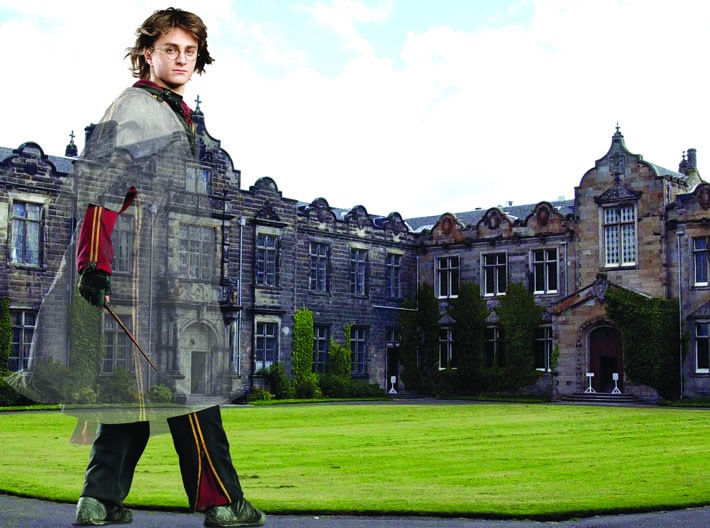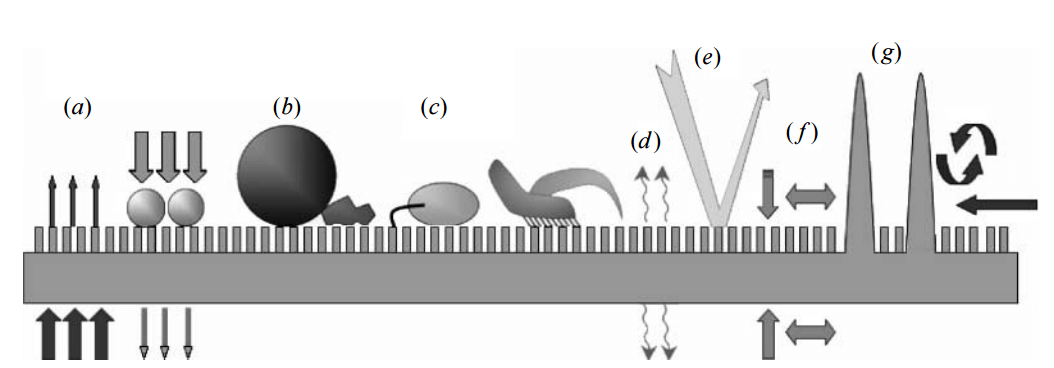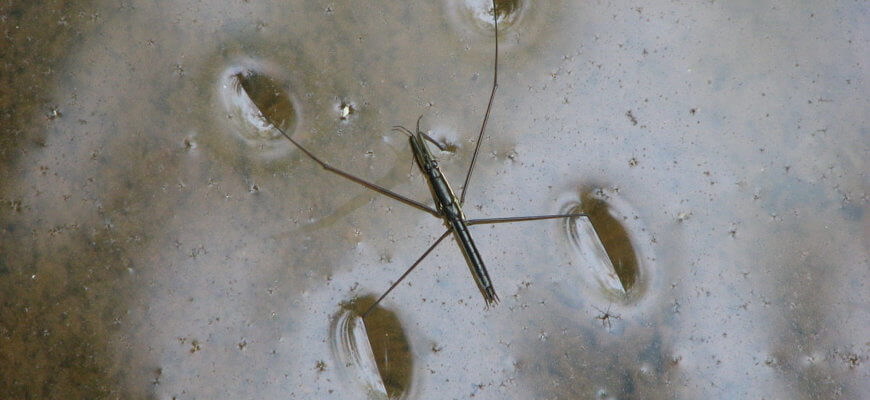Greetings readers, a very happy new year.
In our third theme session, we are going to discuss about surfaces. The year started with big news on functional surfaces. Scientists of the Karlsruhe Institute of Technology (KIT) have developed a new process to achieve functional surfaces, this process so far was irreversible (1). This provides a productive insight into designing functional surfaces with multiple adaptations. We could stack multiple layers with different functions like water resistance, camouflage, light filtration and so on. Well easier said than done, but this could very well be the first step to achieving the invisibility cloak we dream of having.
UV light for producing customized surfaces. Karlsruhe Institute of Technology

Figure 1
The first thought that comes to my mind when I think of surfaces is boundaries. We mostly associate surface of anything to where the object ends. For the purpose of this theme we will be talking about the interactions happening at the surfaces. The interactions can happen between multiple phase combinations like solid–vacuum interface, solid- solid, solid–liquid, solid–gas and liquid–gas (2).
Natural surfaces:
So why am I only interested in natural surfaces is the question?
Well, I am not against man made surfaces, but we use the surfaces as boundaries or end point of the object. Nature on the other hand, uses surfaces as a controlled medium of interaction with the surroundings. Nature uses surfaces for functions like protection, feeding, moisture exchange, light filtration, water repellence, mechanical adaptations and for interaction with the environment.
The leaf surface is an excellent example of functional surface. Leaves are an important working part of a plant and they need to be protected at all times. Leaves are often subjected to harsh conditions and the surface of the leaf provides multiple functions. One of the most prominent one is lotus effect shown below the video below.
If we consider just the surface of a leaf, we come across so many functional uses of the leaf’s surface.

Figure:2 -Leaf surface functional adaptions
(a) Self-cleaning – against contamination, pathogen attack, attachment of insects
(b) Surface wettability – water repellent
(c) Self-cleaning – against contamination, pathogen attack, attachment of insects
(d) Signaling – host-pathogens & insect recognition
(e) Optical properties – radiation protection
(f) Mechanical properties
(g) Heat control
Natural surface as a filter:
These surface adaptations are not limited to plants. Camels conserve water in hot climates using the same technique. Surface inside the camel’s nose helps to conserve water by using hygroscopic properties to remove water from the air during exhalation (4). Camels perform this feat by two mechanisms, cooling exhaled air and during the night extracting water vapor from exhaled air (5). This phenomenon is described in detail in one of our previous guest articles:

Figure: 3- (a) Camel conserves moisture in harsh conditions (b) Tapeworm close-up image holding 8.8 mm long in the parasitological museum in Tokyo.
Surface as a membrane:
Tapeworms are of the class Cestoda of segmented flatworms (Platyhelminthes). They are parasites, hence they need another living being as a host usually live inside the intestines of vertebrate animals. The surface of a tapeworm’s body (shown in figure 3b) acts as a membrane which can absorb nutrients directly. It feeds from a host’s intestines via absorbing vital nutrients.
Surfaces as mechanical sound generators:
Cicadas are a super family of insects in the order Hemiptera (true bugs). Male cicadas are known for the ability to sing songs. Their abdomens consist of drum-like organs, they flex these organs (tymbals) in order to make sound. A clicking noise is produced when they contact the muscles inwards and when the pressure is relaxed the tymbals return to normal position making other noise. Their hollow abdomens serve as sound boxes amplifying the sound (7).
Low frictional surfaces:
Aquatic animals are constantly faced with a solid-liquid interaction at the surface. This generates friction which makes it harder to swim in the water. But many aquatic animals have developed strategies against it. Sharks are capable of moving under water with great speed and efficiency. Their skin is designed to reduce drag by five to ten percent (8). Shark skin also prevents marine organisms from attaching, not because of the lotus effect, but because it is hydrophilic, shark skin gets wet in water (8).

Figure: 4
Desert lizard is another excellent example of surface functionality. The lizard swims through sand like fish through water. This topic will be discussed in detail by guest author in the coming weeks.
To conclude, natural mechanisms are filled with functional surfaces and serve as a great role model for our scientists. In the coming weeks each one of us will pick a one functional surface which interests us and discuss it in detail. If we have raised your curiosity and you would like to know about any specific functional surface, write back to us. 🙂
References:
- ScienceDaily. (2017). UV light for producing customized surfaces. [online] Available at: https://www.sciencedaily.com/releases/2017/01/170116091638.htm [Accessed 20 Jan. 2017].
- Prutton, M., 1994.Introduction to surface physics. Clarendon Press.
- uni-freiburg.de. (2017). [online] Available at: https://www.cpi.uni-freiburg.de/teaching/lecture-surface-coating-techniques/2011-lecture-surface-coating-techniques-genzer-bioinspired [Accessed 20 Jan. 2017].
- Team, A. and Team, A. (2016).Nasal surfaces remove water vapor : Dromedary – AskNature. [online] AskNature. Available at: https://asknature.org/strategy/nasal-surfaces-remove-water-vapor/#.WIHg9fkrLcs [Accessed 20 Jan. 2017].
- Schmidt-Nielsen, K. et al. “Desaturation of Exhaled Air in Camels.” Proceedings of the Royal Society of London. Series B, Biological Sciences, vol. 211, no. 1184, 1981, pp. 305–319. www.jstor.org/stable/35545.
- Shuker, K., 2001.The hidden powers of animals: uncovering the secrets of nature. Readers Digest.
- Pringle, J.W.S., 1954. A physiological analysis of cicada song.Journal of Experimental Biology, 31(4), pp.525-560.
- Bhushan, B. (2009). Biomimetics: lessons from nature-an overview.Philosophical Transactions of the Royal Society A: Mathematical, Physical and Engineering Sciences, 367(1893), pp.1445-1486.
Figures:
-
St-andrews.ac.uk. (2017). 2010 | University of St Andrews. [online] Available at: https://www.st-andrews.ac.uk/picture-this/2010/name,59487,en.php [Accessed 20 Jan. 2017].
-
Bhushan, B. (2009). Biomimetics: lessons from nature-an overview.Philosophical Transactions of the Royal Society A: Mathematical, Physical and Engineering Sciences, 367(1893), pp.1445-1486.
- (a)News.civilserviceindia.com. (2017). [online] Available at: http://www.news.civilserviceindia.com/wp-content/uploads/2014/07/camel_Rajasthan_state_animal.jpg [Accessed 20 Jan. 2017].
(b)Flickr. (2017). Tapeworm. [online] Available at: https://www.flickr.com/photos/51968249@N08/4779333214/in/photostream/lightbox/ [Accessed 20 Jan. 2017]. - Anatomy To You. (2016). In Focus: ‘Skin teeth’ stories: using shark denticles to look to their past. [online] Available at: https://anatomytoyou.com/2016/01/27/skin-teeth-stories-using-shark-denticles-to-look-to-their-past/ [Accessed 20 Jan. 2017].
- Featured image credits Praveen, 7 jan 2010. https://commons.wikimedia.org/w/index.php?title=File:Water_strider,_from_Kerala.JPG&wteswitched=1#



